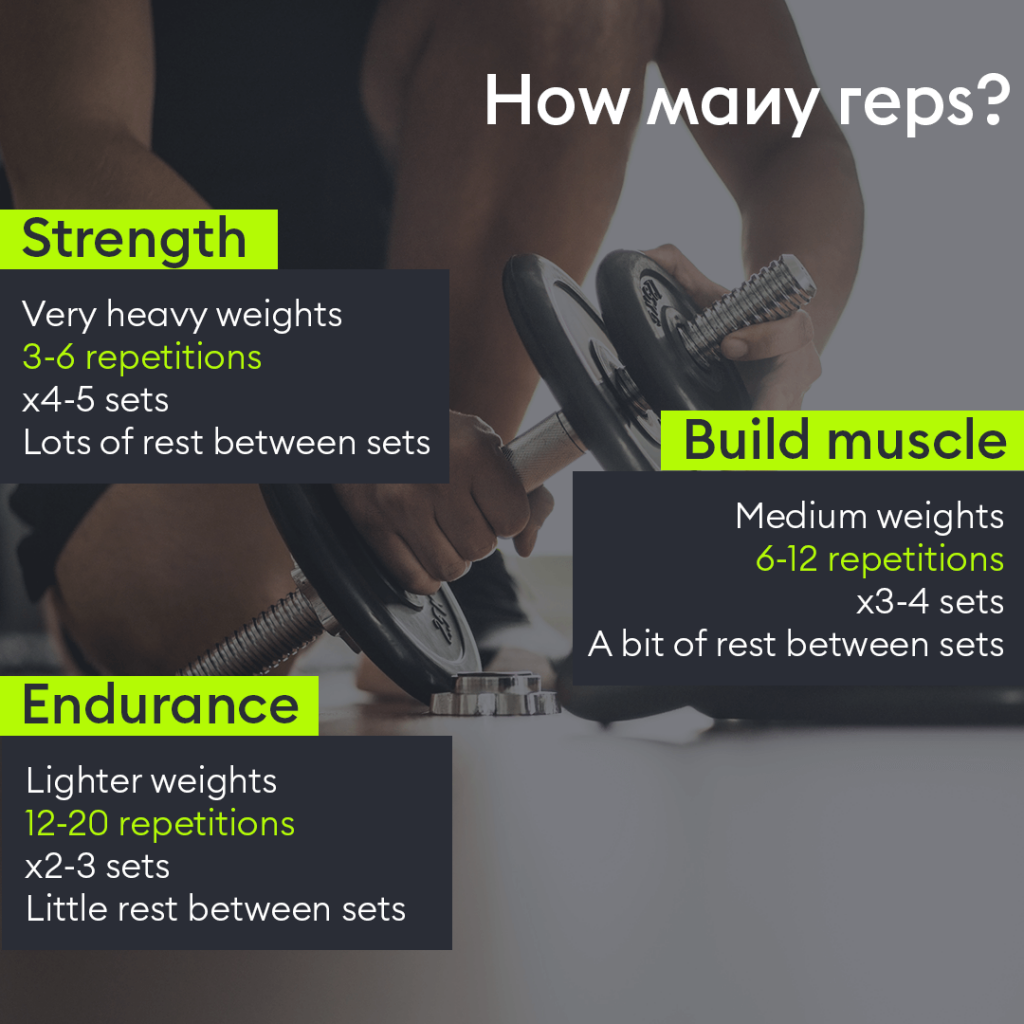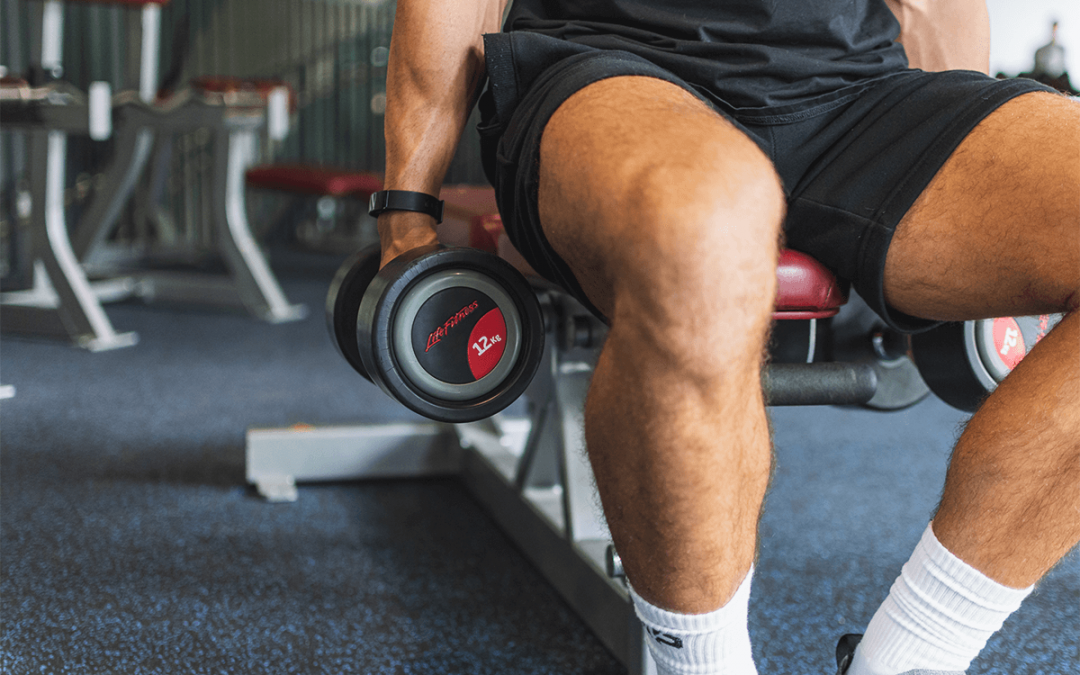In the gym or at home, we often have to craft our own fitness routines that match what we’re looking for that day. Whether we’re using heavy barbells, light dumbbells, or maybe just our own body weight, each exercise we do presents us with a different challenge.
More often than not, we apply a little bit of guesswork when deciding how many repetitions of an exercise to do. Stop when it feels too challenging. That sounds about right. And to be honest, it kind of is.
But choosing the number of repetitions of an exercise you do can stimulate real progression towards your fitness goals. And because our fitness goals are specific and important to us, it’s worth understanding a little more about the ranges worth choosing.
Understanding your fitness goals
It’s crucial to have a goal to make any sort of progress or change in your fitness. Without an idea of what you want to achieve by doing exercise, you will probably feel unmotivated and deflated by the prospect of it.
Set a fitness goal and be specific about it. The more detail, the better. Try and translate generic goals into more concrete ones. Instead of ‘I want to be fitter and tone up’, try ‘I want to do more HIIT classes and not feel as tired, and I also want to see more muscle definition in my legs’. By doing this, you can better dissect the actions you need to take to get you there.
What is resistance training?
Resistance training describes any exercise you do that asks your muscles to contract against a weight or force. It’s the core part of most workouts because that resistance could be dumbbells, kettlebells, a resistance band, or your own bodyweight.
You’re conditioning your muscles by resistance training, which brings with it a whole host of benefits. Bigger muscles. More defined muscles. Increased strength. Increased energy. Plus, tons of secondary effects like better sleep, improved mood, more self-esteem, better weight management, decreased risk of injury, better posture, and much more. It’s safe to say resistance training should play a role in everybody’s fitness routine.
The different aims of resistance training
Although resistance training can be grouped as one type of exercise, different training aims can lead to different outcomes. A PT might consider a pyramid of varying training aims when instructing exercise, but let’s just focus on the 3 most common.
To tone up and go for longer: Endurance
Muscular endurance is a type of fitness in itself, and we all need it. It described the ability of your muscles to do more for longer. Muscular endurance is what your core needs to support you. Your back muscles need it to maintain your posture. It’s needed for lots of important everyday things.
Increased muscular endurance often leads to a ‘toned’ or ‘lean’ appearance that many people seek. You have two types of muscle fibres, and these endurance fibres are one of them.
To train for muscular endurance, use a lighter resistance but for more repetitions. That lighter resistance depends on your body and the exercise at hand. For your legs, it might mean lots of squats with a medium kettlebell. For your shoulders, it might mean some overhead presses with two fairly light dumbbells. For your core, it might mean just holding a plank. Choose a weight that you’re able to complete your rep and set range with, making sure your posture for each exercise stays perfect.
Lots of HIIT or circuit classes will focus on improving muscular endurance as well as cardiovascular fitness too. Everybody needs endurance. Without it, you won’t be able to train for other purposes like building muscle or improving strength.
If this is your goal, try the following rep ranges:
12-20 reps
2-3 sets
30-60 seconds rest
To get bigger muscles: Hypertrophy
A common goal for lots of people is to get bigger muscles. Hypertrophy is when your muscles increase in cross-sectional size and give you the overall appearance of looking more ‘muscley’. Although hypertrophy can also increase strength, it shouldn’t be confused with being the same thing as strength training. It’s a little bit like layers of a cake. Hypertrophy is the middle layer between endurance and strength.
To increase the size of your muscles, you will lift weights that are a little bit heavier. To do this, the tempo of your workout will slow down. You’ll need to focus on executing the exercise with the correct form, and you’ll also need more time for recovery in between.
Pick a weight that you can hit the right rep range with. If it feels too easy, increase the weight. If it’s too hard, decrease it. Remember, it all depends on the exercise at hand. For lots of people, bodyweight is heavy enough to increase muscle mass in exercises such as push-ups.
If this is your goal, try the following rep ranges:
6-12 reps
3-4 sets
1-2 minutes rest
It’s worth noting that muscle can be built across many rep ranges. But, if you’re just getting started with it, these figures are a good guide of where to focus your efforts.
To increase strength: Strength
Strength training is a bit more specific in what it’s trying to achieve. By definition, you’re looking to increase the amount of force your body can produce. This happens by increasing the number of muscle fibres you have (the second type of the two mentioned earlier) and neural changes that occur when your brain gets used to heavy resistance demands. For that reason, training to achieve this has its own asks.
Strength training is often associated with lifting very heavy weights. Those that spend lots of time at the benches and racks in the gym are usually there to strength train. However, increases in strength depend on your baseline level of it. For lots of people, strength training includes dumbbells they might have at home and even their own body weight. If you can only just hit the rep and set ranges for an exercise, you’re going to be improving your strength by doing it.
Because strength training asks so much from the body, it’s important to take your time with it. Fewer reps mean focusing on your form. It’s crucial to do this to avoid injury. You’ll also need much more rest both between sets and between sessions.
If this is your goal, try the following rep ranges:
3-6 reps
4-5 sets
2-4 minutes rest

Understanding training aims helps to give some guidance to your workout structure. But these are not strict boundaries that cannot be crossed. There are many different training structures and systems that overlap across many rep ranges. Pushing past your usual limit doesn’t mean you’re suddenly going to lose progress in one area and gain it in another. Just remember that lifting more for fewer repetitions helps build strength, and lifting less for more repetitions helps with endurance. We all need both. So, bear that in mind.
3 tips for choosing your rep ranges:
1. Link it back to your fitness goal
When deciding how many times to do an exercise, think about what you want to achieve. This might differ by muscle group and your current ability in each.
The rep ranges can guide you through how many repetitions you should do, how many sets of repetitions you should do, and how much rest you’ll need between these sets.
This way, you can assess the demands of the exercise on your body and understand where you are in terms of ability and progress.
2. Don’t wed yourself to a training aim
When starting out on a fitness journey, you don’t need to decide on an overall training aim and stick with it forever. You also don’t need to conform to any stereotypes too, by the way.
It’s more than okay to invest time in lots of different training aims. Perhaps sometimes you like to challenge your lower body with a strength session. Other days you might go for a full body endurance workout.
No single training aim is better than another. A mixture of lots of things can help you improve well rounded physical fitness. It all depends on your current ability, the progress you’re looking to make, and most importantly, what you enjoy doing.
3. Acknowledge abilities of different muscles?
Some muscle groups are stronger than others. It depends on who you are and your experience with exercise so far. Perhaps the muscles in your upper body are in a better condition than the ones in your lower body or vice versa. Maybe you even have a muscular imbalance where your right arm is a lot stronger than your left.
Choosing a weight and a number of repetitions will depend on the muscle group and what you’re looking to do with it. Don’t expect to be able to perform at the exact same levels for every exercise.
Plus, remember that some muscles, like your core, are better suited to endurance training than strength training. For example, you’re probably going to do 20 bodyweight sit-ups than 3 sit-ups holding a ridiculously heavy weight. That would be silly.
Understanding how the number of exercise repetitions can help you achieve your goals is an excellent source of motivation to move forward with. It’s a helpful bit of information to be aware of when starting out.
However, don’t worry too much about these exact figures and feel unable to stray from them. Some classes, training styles, or PTs might ask for something slightly different on occasion, and there’s no strict boundary you can cross that will make your exercise ineffective. Be mindful, use it to your advantage, but above all, enjoy what you’re doing.



